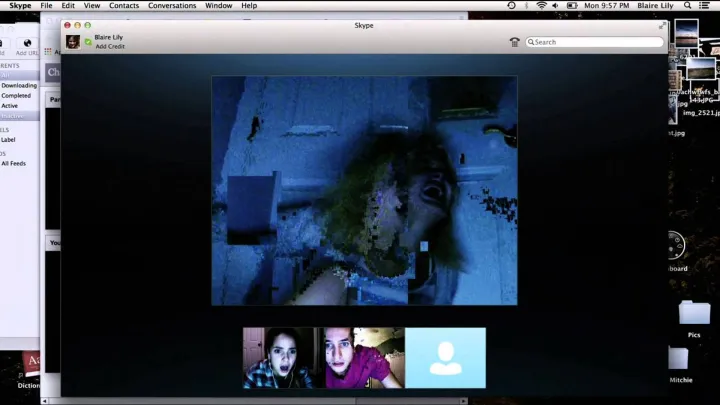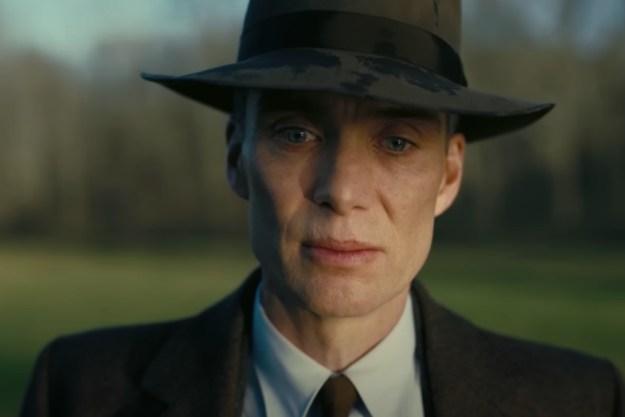It’s no exaggeration to say that the internet has fundamentally reshaped life, the world, and maybe even how we perceive reality. So why have so few movies these past few decades reckoned with that scary truth? Perhaps doing so would be a passive acknowledgment that cinema is losing the battle for attention spans to the bottomless abyss of the web. Or maybe it’s just that filmmakers still haven’t entirely cracked the secret to making people staring at tiny screens — the dominant activity of our age — exciting or visually interesting. Whatever the reason, it’s a very short list of films that have much to say about the technological advancements that changed everything.
Toward the top of that list, maybe at its summit, is Unfriended. Yes, really: A low-budget techno slasher named for Facebook lingo remains one of the few movies released in the wake of our mass virtual migration to muster any real perspective on it. Eight years ago, Unfriended silenced the groans of skeptical horror buffs (“oh great, another FeardotCom”) by turning out to be much more fiendishly clever than a logline or its moniker might suggest. Today, one could go further in describing it as an essential portrait of the 21st century — a thriller that captures not just how so many of us now experience daily life but the way that digital scrim has replaced the normal fabric of society, with empathy as a major casualty.
The first thing we see in Unfriended is a tweaked version of the Universal Pictures vanity card: As the glowing globe spins in space, both the image and the accompanying theme of triumphant horns glitch and degrade, scrambling this familiar intro into an unfamiliar mess of digital noise. It’s a perfect opening expression of the film’s notion of the internet as a destabilizing filter of ones and zeroes, corrupting our perspective on the world and each other.
Plotwise, Unfriended is basically an online version of I Know What You Did Last Summer. A half-dozen preppy, nattering high-school friends log on for a group video chat on what turns out to be one year to the day since their classmate, Laura Barns, took her own life after embarrassing cell phone footage of her went viral. Over the course of about 80 minutes, we learn the full extent to which Laura’s supposed friends were responsible for her public humiliation; revealing their culpability is the digital phantom of the deceased, enacting her supernatural revenge via tactics that escalate from lurking to harassment to, oops, your hand is in a blender.
Its entire narrative unfolds in real time, through a single, unbroken shot (in reality, several long takes seamlessly stitched together) of a laptop screen.
This slim, nasty story proves less notable than how director Leo Gabriadze goes about telling it. Unfriended takes the form of a feature-length screencast of a MacBook. Which is to say, its entire narrative unfolds in real time, through a single, unbroken shot (in reality, several long takes seamlessly stitched together) of a laptop screen. We see the main character, Blaire (Shelley Hennig), only through the lens of her webcam. And her friends appear as faces in Skype boxes, sometimes obscured by the various applications and windows otherwise occupying the rectangular frame of Blaire’s desktop.
Unfriended wasn’t the first movie to adopt this gimmick, which producer Timur Bekmambetov would later dub Screenlife: Nacho Vigalondo and Joe Swanberg offered earlier variations on it, to say nothing of that clever Google commercial that told a whole love story through search results. But it was Gabriadze and Bekmambetov who elevated the format into a trend (and maybe an art form) by fully exploiting its possibilities. What The Blair Witch Project is to found footage, Unfriended is to the laptop thriller: The most committed, convincing application of a fresh storytelling device.

Whereas so many movies, even cyberthrillers, resort to generic, imaginary websites and search engines, Gabriadze privileges nearly complete verisimilitude of interface, thanks to his use of real apps and daily bookmarked destinations: Google, Gmail, Facebook, Spotify, iMessage, and Skype all factor into its plot mechanics and visual vocabulary. It’s funny to think of how completely incomprehensible this film might look to the audiences of, say, the mid-’90s when Hollywood movies like Hackers and The Net were dipping a tentative toe into the waters of internet culture. Blaire toggles and browses and processes multiple layers of graphical information with the multitasking ease of someone who’s grown up online — which is to say, exactly the way the film’s target demographic can.
It’s brilliant how the film adapts the habits of second-nature web surfing into new methods for delivering information, both expository and psychological.
Unfriended is keyed into how everyone, but especially a younger generation, communicates and operates in the internet age. It’s brilliant how the film adapts the habits of second-nature web surfing into new methods for delivering information, both expository and psychological. The backstory is dispensed via social media posts and links to news pieces; we learn that Laura was cyberbullied to suicide via the step-by-step process Blaire takes to memorialize her seemingly hacked Facebook account. In place of the usual paranormal expert dragged in to explain the nature of the haunting, Unfriended tabs over to a blog post. Most inspired is the moment when Blaire types and retypes a message about Laura’s traumatic past, searching for the right words — a bit of second-guessing that tells us something about both girls.
This is a new language of horror, one steeped in an assumed familiarity with the hiccups of computers. Giving new meaning to the phrase “spinning pinwheel of death,” Unfriended creates jump scares from the blackouts and freeze frames of a faulty connection, building suspense with inopportune breaks in the feed and shock with the images of death and terror that come blipping onto the screen when the Wi-Fi suddenly kicks back in. More subtly, even commonplace elements of internet interaction become menacing through context: Message notices dipping down into the upper righthand corner of the frame inspire pinpricks of anxiety, and the usual faceless silhouette of a default profile image suddenly starts to resemble a Michael Myers or Ghostface mask — though, of course, the filmmakers fully understand that seeing a blank avatar in your replies or chat window is already a sign that you’re about to have an unpleasant interaction.
So much of horror is about creating a sense of normalcy and then violently, uncannily disrupting it. Unfriended runs with that idea by meticulously offering a facsimile of ordinary, mundane online activity that it can unsettlingly… unsettle. Like those watching from home, Blaire and her friends know their applications and websites of choice inside and out. Long before they’re possessed into putting a blade or gun to their flesh, the teens are spooked by evidence that something isn’t right — the way, for example, that the report/block button on Facebook has disappeared (a truly haunting development for anyone who spends any amount of time on social media) or how photos seem to be uploading automatically to their pages. If Jaws made audiences afraid to go to the beach and Psycho made them afraid to take a shower, Unfriended has the insidious power to get its viewers thinking twice about logging on.
Unfriended goes further than depicting its lambs on the way to slaughter as obnoxious sex-and-drug-starved idiots.
Of course, the real threat Laura Barns poses to these doomed teenagers is exposure. She’s like a phantom black light, revealing all the dirty sins of her social circle. Is that a particularly 21st-century nightmare: To be held accountable for things you said or did from the supposed safety of online anonymity? It’s standard slasher protocol to make us hate the kids being knocked off one by one by a vengeful killer. But Unfriended goes further than depicting its lambs on the way to slaughter as obnoxious sex-and-drug-starved idiots. They’re genuinely terrible people, liars who conceal their betrayals from the world and each other — a damning reality that comes fully into focus during the film’s tour-de-force centerpiece sequence, a game of Never Have I Ever with life-or-death stakes.
This is where Unfriended moves from ingenious fun to something more scathingly perceptive. Laura’s cyberbullying victimizers-turned-victims have learned to separate their public image, and their self image, from the toxic impulses they indulge from their keyboards. What they do online doesn’t “count,” effectively — it might as well be a different person secretly posting that embarrassing video or telling that peer to go kill herself. They’re experts, in other words, at compartmentalizing. And the film mirrors that dark talent in lots of visual and conceptual ways: Dividing the frame into boxes and boxes within boxes; creating overlapping layers of conversation, as when what Blaire says to the group deviates from the private messages she types out to her boyfriend (Moses Storm).
You could say the real horror the movie is tapping into is the sociopathy of web culture — how so many behave in a way online that they never would in person. Unfriended’s expert replication of a night on the computer, free of any cheating on the conceit (there are no zooms into particular quadrants of Blaire’s screen, no breaks from her first-person perspective, no escape from the claustrophobia of the gimmick), creates the impression of a whole life lived between the four artificial walls of a laptop screen. To disappear into that life, the film eventually concludes, is to dissociate from reality as we’ve long known it. Online, it’s easy to forget who you are, or that the user on the other side of the digital void is a person, too — an idea reinforced, with darkly comic inspiration, by a scene of Blaire being rapidly cycled through Chatroulette sessions, her cries for help ignored by strangers, like the Kitty Genovese of legend.
Unfriended‘s indictment of the internet as an open opportunity for cruelty remains as disturbingly relevant as ever.
Unfriended has aged a bit, culturally and technologically speaking, over the last almost decade. (Are there even still teens who use Facebook? Does anyone still use Skype?) But its indictment of the internet as an open opportunity for cruelty remains as disturbingly relevant as ever. The film spares no one, not even its heroine: A final revelation implicates her, too — and, by extension, the viewer, experiencing the events of the film from the exact same perspective, is provoked into considering their own potential lapses in compassion. Our applications and websites might change, but there’s no indication that the internet as a direct conduit to (and tool for) sadistic abuse has.
It’s in its bleak final seconds that Unfriended finally breaks from its established POV, as Blaire closes the laptop we’ve been watching over her proverbial shoulder and is confronted with a real world that exists outside her online bubble, plus some very real consequences. Whether that last ghostly jolt looks like a nightmare come true or a fantasy of actual comeuppance for the cyberbullies of the world may depend on whether you’ve been on the giving or receiving end of the abuse — or maybe just how well you’ve convinced yourself that it’s all fun and games in the digital realm.
Unfriended is currently streaming on Netflix. For more reviews and writing by A.A. Dowd, visit his Authory page.
Editors' Recommendations
- Forget Netflix and chill: This is the best streaming service for binge watching on weekends
- Is the MonsterVerse the best bad movie franchise ever made?
- Max celebrates Women’s History Month with tons of movies, TV shows, and original programming
- Furiosa: Why the Mad Max prequel is the most anticipated 2024 action movie
- 10 best sci-fi movies of 2023, ranked




